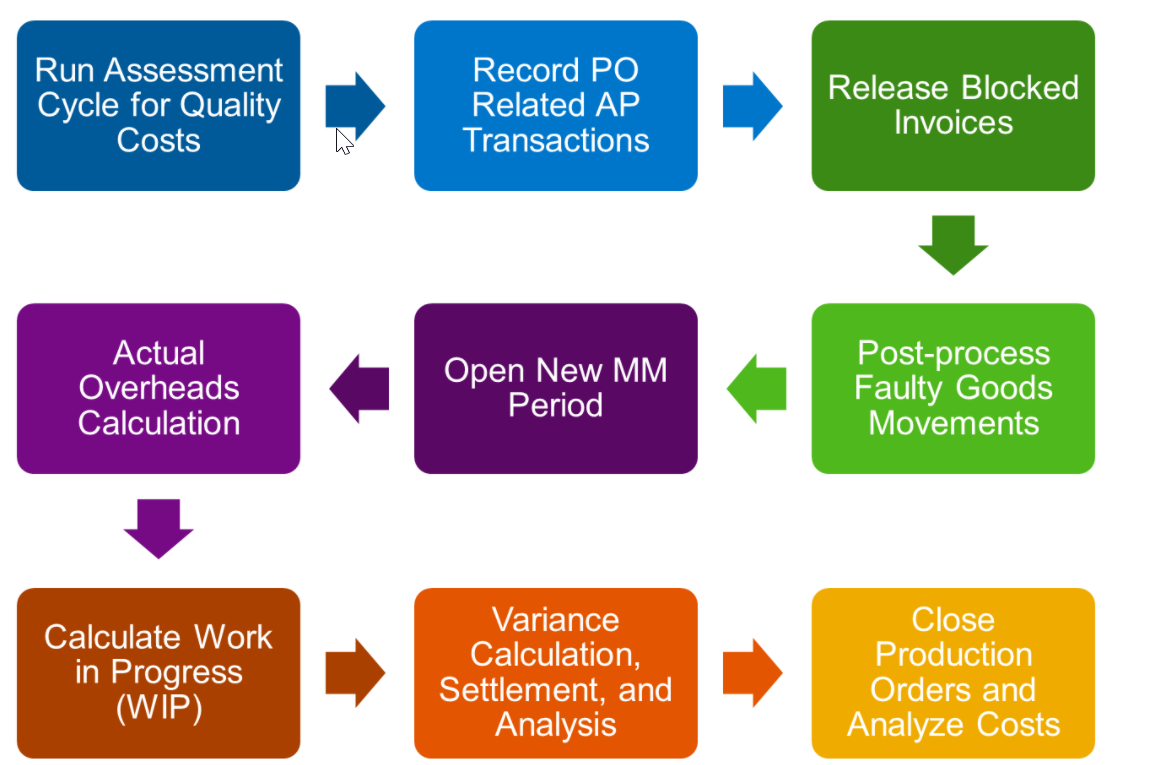
- SAP Community
- Products and Technology
- Enterprise Resource Planning
- ERP Blogs by SAP
- Period-End Closing for Integrated Components
Enterprise Resource Planning Blogs by SAP
Get insights and updates about cloud ERP and RISE with SAP, SAP S/4HANA and SAP S/4HANA Cloud, and more enterprise management capabilities with SAP blog posts.
Turn on suggestions
Auto-suggest helps you quickly narrow down your search results by suggesting possible matches as you type.
Showing results for
former_member32
Explorer
Options
- Subscribe to RSS Feed
- Mark as New
- Mark as Read
- Bookmark
- Subscribe
- Printer Friendly Page
- Report Inappropriate Content
08-19-2021
10:44 AM
Overview of the period end activities in SAP S/4HANA Cloud - Part1
During period-end, modules integrated with financials in SAP S/4HANA Cloud have process steps that are executed as part of the financial period and year-end close. These process steps concern the inventory valuation at year end, as well as period-end closing activities for maintenance orders, plants, and projects
In this blog we will have an overview of the period end activities shown below. In this blog we will discuss Period- End Closing, In the upcoming blog we will discuss on Year-End Closing.

Period-End Closing
Period-End Closing - Maintenance Orders (BF7)

Period-end closing for maintenance orders supports the activities required for the Preventive Maintenance (BJ2) and Corrective Maintenance (BH1) scope items. Once the cost is recorded for the Maintenance Order, Preventive Maintenance, and Unplanned Maintenance order types, you close the period by means of settlement, closing, and reporting.
In the first step, you settle the maintenance orders to the responsible cost centers or other relevant cost objects. Then, you check and close the orders that are completed. In the final step, you verify that the actual values on maintenance orders through reporting.
Period-End Closing – Projects

The period-end closing activities for projects support the settlement of costs that are temporarily collected in projects, to one or more receivers as part of period-end processing for projects.
When you maintain a project, you create the settlement rules for the associated costs and revenue. You can either define a settlement strategy or configure direct settlement (which is simpler). If you have complex projects or changes to settlement rules, you can generate the settlement rules periodically, as part of period-end closing. Costs and revenues posted to a project during the period are settled onto multiple receivers during period-end by executing the settlement run, in accordance to the rules maintained for each project. With overhead costing you can allocate indirect costs (like those settled from projects) to the appropriate objects. Using the costing sheet, you can transfer indirect costs to the final cost of the product or process. Finally, you can execute plan - actual reporting to track the project execution.
When executing the plan actual report, you should filter out the RMRP (purchase order payable liability) and KOAO (result of settlement) transaction types to provide a detailed view of costs and nature of the charges of the project.
Period-End Closing - Plant (BEI)

This process ensures that all costs incurred during the manufacturing process are assigned to production activities.
The steps generally include running an assessment to allocate quality activity related costs onto the cost centers designated for manufacturing. Then, all open purchase orders (POs) are analyzed for correctness, the blocked invoices are released, and any goods movements with errors are reprocessed in accordance to their errors.
Stock and valuation data are managed by period. For values and goods movement to be posted to the correct period, the period must be set whenever a new period starts to perform material movements. This activity must be run when no one is handling a material in the system.
When the new MM period is open, you allocate the actual overheads to production orders, process orders and product cost collectors according to pre-specified overhead rates. You also calculate the work in process (WIP) for production orders. You perform the variance calculation for the orders and then settle these to Financial Accounting. Finally, you close any completed production orders.
Image and Content Source:
SAP knowledge base and Best practices: SAP Best Practices
SAP S/4HANA Cloud User Community: Follow it
If you have any Queries and comments on this Blog post kindly use the QNA link.: QNA
- SAP Managed Tags:
- SAP S/4HANA Finance
Labels:
1 Comment
You must be a registered user to add a comment. If you've already registered, sign in. Otherwise, register and sign in.
Labels in this area
-
Artificial Intelligence (AI)
1 -
Business Trends
363 -
Business Trends
23 -
Customer COE Basics and Fundamentals
1 -
Digital Transformation with Cloud ERP (DT)
1 -
Event Information
461 -
Event Information
24 -
Expert Insights
114 -
Expert Insights
158 -
General
1 -
Governance and Organization
1 -
Introduction
1 -
Life at SAP
415 -
Life at SAP
2 -
Product Updates
4,684 -
Product Updates
218 -
Roadmap and Strategy
1 -
Technology Updates
1,502 -
Technology Updates
89
Related Content
- Quick Start guide for PLM system integration 3.0 Implementation/Installation in Enterprise Resource Planning Blogs by SAP
- Business Rule Framework Plus(BRF+) in Enterprise Resource Planning Blogs by Members
- Futuristic Aerospace or Defense BTP Data Mesh Layer using Collibra, Next Labs ABAC/DAM, IAG and GRC in Enterprise Resource Planning Blogs by Members
- SAP Enterprise Support Highlights Resources to Achieve a Clean Core in Enterprise Resource Planning Blogs by SAP
- Asset Management in SAP S/4HANA Cloud Private Edition | 2023 FPS01 Release in Enterprise Resource Planning Blogs by SAP
Top kudoed authors
| User | Count |
|---|---|
| 13 | |
| 11 | |
| 10 | |
| 7 | |
| 7 | |
| 6 | |
| 5 | |
| 4 | |
| 4 | |
| 4 |